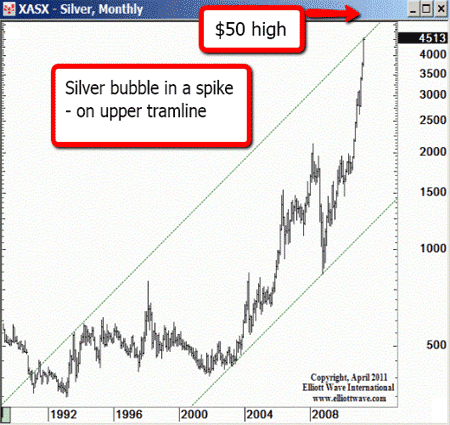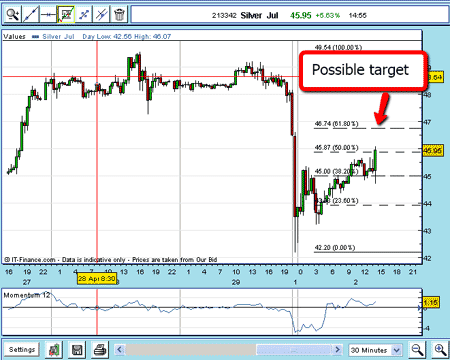Silver - a classic example of investors herding
Silver has been in a major bull run since at least 1992. But the recent pullback has left many traders with big losses. So timing your exit from the market is crucial, says John C Burford. Here, he explains how Elliot wave and Fibonacci techniques can help you stray from the herd but still hold on to your profits.
As I write this on the May Bank Holiday Monday, I see that there has been an even bigger slide in the silver price than we saw on the previous Monday (the Easter Monday holiday).
Last Monday, we saw the market run up and top at near $50, drop by more than 8% on Monday to the day's low, then tack on another 3% fall on Tuesday, when UK traders were back at their desks.
Those traders who were long (and that means the vast majority) must have felt that the Easter weekend was a very expensive break away from the markets.
MoneyWeek
Subscribe to MoneyWeek today and get your first six magazine issues absolutely FREE

Sign up to Money Morning
Don't miss the latest investment and personal finances news, market analysis, plus money-saving tips with our free twice-daily newsletter
Don't miss the latest investment and personal finances news, market analysis, plus money-saving tips with our free twice-daily newsletter
And so today, the market has dropped from the $49 area on Friday to an overnight low of $42 a massive decline of 14%.
Anyone trading futures or spread-betting silver from the long side would almost certainly have placed their stop-loss sell orders within this range and be stopped out for losses, or very much-reduced profits.
Silver's bull market is older than you might think
I am certain that many silver bulls will have lost much money today, especially those buying last week. But the market has been in a major bull run since at least 1992 that is a very long-in-the-tooth 19 years:

(Chart courtesy ofelliottwave.com. Click on the chart for a larger version)
(Since taking this chart, the market has made its $50 high in a spike above the upper tramline).
The severe downdrafts of the two Mondays have shown why most traders lose money despite being on the right side of the trend.
The fact is, it's all very well guessing the trend correctly, but it is how you exit the market that determines the winners.
Before the two huge dips, were there any clues the market was about to swoon? I believe there were:
Examining the above chart, the run-up to $50 was near-vertical in recent months. And the rally from the 2008 low at $8 has had no major correction (in almost three years). The bulls have been piling in recently (see the latest data of Commitments of Traders Report from the CFTC
And when traders pile in after a huge and lengthy rally, (as they always do), an end is nigh.
The tramlines shown in the chart are very reliable. The lower one connects the two major lows and the upper one lies parallel even on this log scale! And now the market has zoomed in a spike above the upper one. That is an unstable situation.
I have read very few articles recently that are bearish on silver. The vast majority have been fully onboard the silver bandwagon. I even saw an article calling for $1,500 silver the other day! But with buying power used up, even a small degree of selling can (and did) produce waves of stop-loss selling. Buying near the $50 level was extremely high-risk.
Importantly, the bullish case made lots of sense from a fundamental standpoint. But fundamental arguments always do until they don't! Then, traders start taking note of the other side of the coin.
Market sentiment (measured by the Daily Sentiment Index at trade-futures.com) has been at record highs for days and weeks and made an all-time 96% high a few days ago. Nearly everyone was on one side of the boat!
Traders have been caught up in classic herding behaviour. They were getting more bullish as prices rose. I have written before on this. Because human nature en masse follows age-old patterns and does not change, these violent market moves are destined to be repeated. From a trader's perspective, they can be forecast with a high degree of accuracy. But you have to be prepared to set your mind against the herd and not be caught up in the excitement of the crowd.
Is this the end of silver's run?
This current decline may or may not be the end of silver's run. There will be many who are 'buying the dip'. As I write, there is a tussle between the buy-the-dippers and the stale longs who will take a rally to unload positions, and also new shorts coming in.
Usually, prices will become very volatile in this period. But here is the latest 30-minute chart (as of Monday 2 May):

(Click on the chart for a larger version)
From this morning's $42.20 low, I can see an A-B-C (which is corrective) rally. The market is running above the Fibonacci 50% level and could make it to the 61.8% level, which is just about where A = C a common relationship.
Many short-term traders will be looking to short around there as they perceive today's rally is corrective in nature.
But in the meantime, much blood has been spilled in silver today and all in a few hours.
It is one of the most treacherous markets I know. But if you can stomach the many spikes (preferably trading the extremes), potential profits can be immense.
NB: Don't miss my next trading insight. To receive all my spread betting blog posts by email, as soon as I've written them, just sign up here .
Get the latest financial news, insights and expert analysis from our award-winning MoneyWeek team, to help you understand what really matters when it comes to your finances.
John is is a British-born lapsed PhD physicist, who previously worked for Nasa on the Mars exploration team. He is a former commodity trading advisor with the US Commodities Futures Trading Commission, and worked in a boutique futures house in California in the 1980s.
He was a partner in one of the first futures newsletter advisory services, based in Washington DC, specialising in pork bellies and currencies. John is primarily a chart-reading trader, having cut his trading teeth in the days before PCs.
As well as his work in the financial world, he has launched, run and sold several 'real' businesses producing 'real' products.
-
 Investors will reap long-term rewards from UK equities
Investors will reap long-term rewards from UK equitiesOpinion Nick Train, portfolio manager, Finsbury Growth & Income Trust, highlights three UK equities where he’d put his money
-
 The graphene revolution is progressing slowly but surely
The graphene revolution is progressing slowly but surelyEnthusiasts thought the discovery that graphene, a form of carbon, could be extracted from graphite would change the world. They might've been early, not wrong.